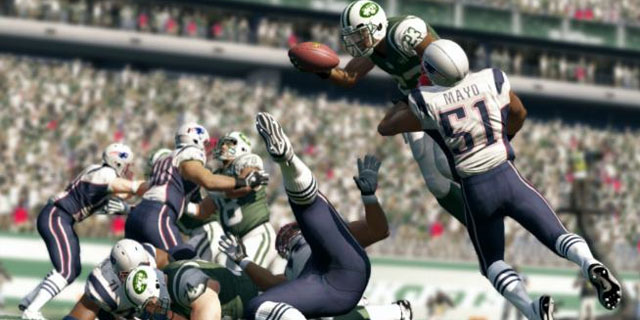
It’s a well-worn sentiment that the Madden series is just the same game, year after year. It’s a view that may seem accurate on the surface, but those who play the games more closely know that the franchise releases in phases, with a particular model being iterated and improved upon for a few years before being totally revamped. These years are interesting ones, as they bring huge gameplay changes, but often end up with a smaller (if fresher) feature set as a result of the extra work on the basics.
This is one of those years.
Madden NFL 13 still has football in it, if you were wondering. Even still, there are some major shifts in how the game’s played in both a micro and macro sense. The big changes come from two sources: the game’s new “Infinity Engine” (seriously), which changes up tackling and other actions on the field, and Connected Careers, a shift of the Franchise and Superstar modes to an integrated, super-multiplayer-focused online experience.
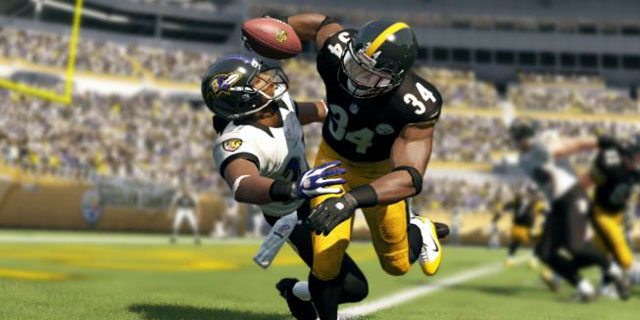
The new tackling and player animation system tries to simulate muscle tension and momentum in realistic ways, and it definitely makes a difference. There’s a distinct Backbreaker feel to a lot of it; the lighting and more natural motions combine to have that same sort of fluid movement. (Thankfully, it’s hooked into the much-more-functional mechanics of the Madden system, making it more enjoyable than its possible inspiration.) There are times when the A.I. isn’t quite tuned to these systems, as players trip or get stuck behind things a bit more often than they should, but the 95 percent of the time when it works well, it’s a refreshing change.
EA also put the focus on revamping the passing game in Madden 13, making play-action more effective and tweaking the pass-defense A.I. to compensate. None of us here are tournament-level Madden players, so the effectiveness of the secondary isn’t really something we can measure, but we definitely noticed it being a lot easier to pull off simple run fakes and find an open receiver for a few yards.
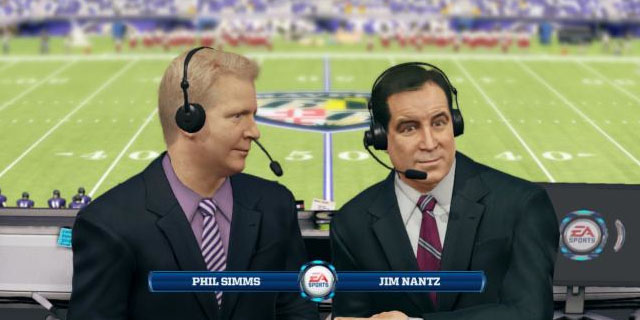
The presentation seems to be continuing its cycle of going for “new,” sometimes at the expense of “better.” For some reason, every time you turn the game on you’ll have to watch random shapes fly by as the view zooms through the scene to get to your menu. There are some cool elements on interface screens, but they sometimes result in load delays between menu tabs, which is not fun to deal with at all over the long term. We also miss the days of the robust, two-toned soundtracks, but Madden 13 rocks a few orchestral tracks for menus and not much else.
Jim Nantz and Phil Simms take over the announcing duties this year, and their CBS broadcast-style feel is a nice change of pace but possibly not a great fit for the less plodding among us. The things they say are insightful if not exciting. Unfortunately, first-year troubles kick in, as the shallow pool of a first-year recording means Simms will remind you how much the defense loves not being on the field almost every first down, and it’s a coin flip whether you’ll get chastised or applauded for a pass that doesn’t get a first down, but it’ll be one of the two. It’s the one aspect of the game that most incentivizes having a dynamic gameplan: as long as you’re totally haphazard, the guys can’t repeat anything.
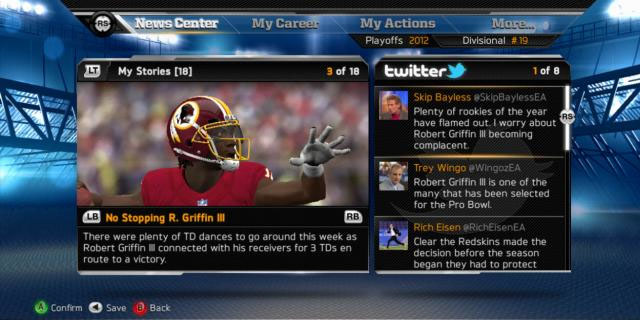
You’ll probably spend most of your time in the new Connected Careers mode. Taking elements of online franchises and mixing in all of the Superstar stuff, Connected Careers lets you and up to 31 other people run through your teams and players in the same league. (Only one player or coach can be controlled for each team.) This means your friends can manage rosters while you build up your rookie wide receiver and take them on with him. It’s a novel concept, and one that has a lot of potential if you have the people dedicated to playing. (Each relies upon a commissioner auto-advancing weeks unless everyone gets in and does their tasks quickly.) All through, there are simulated Twitter accounts from various commentators (like Skip Bayless and Chris Mortensen), which seemed really gimmicky to start but felt genuinely cool when my undrafted rookie QB occasionally caught their eye. There are also new scripted events that can happen over a career, like players coming back from retirement or draft prospects having scandals or breakthroughs in college.
Since these are all online, it means you can access stats and take some actions on the Madden site, like responding to trades (if you’re a coach) or spending points on stat upgrades (if you’re a player). Also, since these are all online, it means that single-player practice scenario you’re running won’t count if you even momentarily lose the server connection in the middle, and you can’t play them at all if the servers ever go down. For those who don’t want to worry about that, you can play offline-only versions of this mode, but you don’t get any of the cool site things or the option to take the game online later.
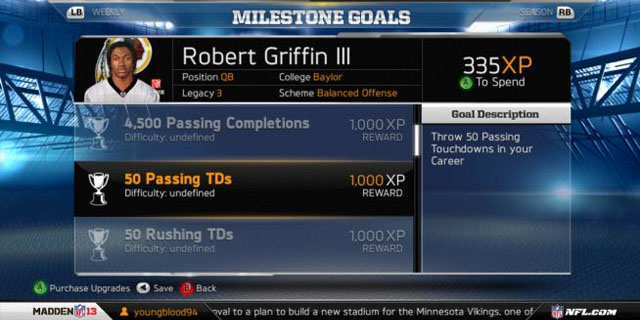
There are a few other items thrown into this year’s package. The Ultimate Team card-based team-collecting feature is back, pack-buying microtransactions and all. It’s an interesting thing to get absorbed in, provided you’re fine with the free-to-play-type model. Madden Moments Live will let you recreate interesting plays and situations from the actual season as the year progresses. There’s even Kinect support on the 360 (though we couldn’t test it; we reviewed the PS3 version). All of these are secondary to the main Madden experience, though, and that’s been definitely reworked.
As always in a rebuilding year, there are kinks to work out, and next year will most definitely be more polished and carry with it a few more features. For now, if you’re looking to play some Madden with a new feel, you can get it here, and if you have the crew ready for the collaborative online experience, it can be truly special.
Pros: New tackling system, Connected Careers’ cool new elements
Cons: Repetitive Simms and Nantz, new-engine kinks and glitches



















